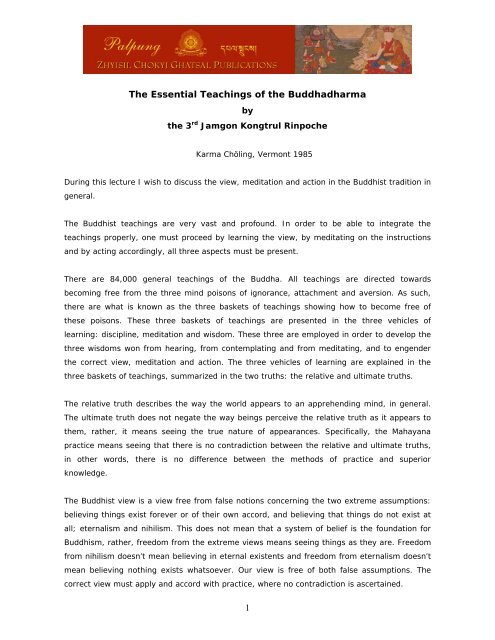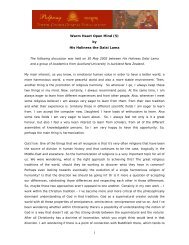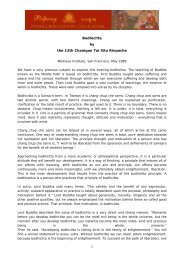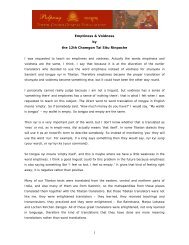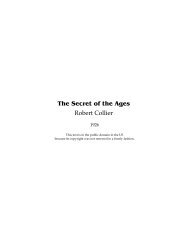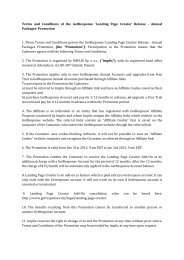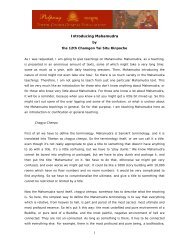1 The Essential Teachings of the Buddhadharma
1 The Essential Teachings of the Buddhadharma
1 The Essential Teachings of the Buddhadharma
- No tags were found...
Create successful ePaper yourself
Turn your PDF publications into a flip-book with our unique Google optimized e-Paper software.
<strong>The</strong> <strong>Essential</strong> <strong>Teachings</strong> <strong>of</strong> <strong>the</strong> <strong>Buddhadharma</strong>by<strong>the</strong> 3 rd Jamgon Kongtrul RinpocheKarma Chöling, Vermont 1985During this lecture I wish to discuss <strong>the</strong> view, meditation and action in <strong>the</strong> Buddhist tradition ingeneral.<strong>The</strong> Buddhist teachings are very vast and pr<strong>of</strong>ound. In order to be able to integrate <strong>the</strong>teachings properly, one must proceed by learning <strong>the</strong> view, by meditating on <strong>the</strong> instructionsand by acting accordingly, all three aspects must be present.<strong>The</strong>re are 84,000 general teachings <strong>of</strong> <strong>the</strong> Buddha. All teachings are directed towardsbecoming free from <strong>the</strong> three mind poisons <strong>of</strong> ignorance, attachment and aversion. As such,<strong>the</strong>re are what is known as <strong>the</strong> three baskets <strong>of</strong> teachings showing how to become free <strong>of</strong><strong>the</strong>se poisons. <strong>The</strong>se three baskets <strong>of</strong> teachings are presented in <strong>the</strong> three vehicles <strong>of</strong>learning: discipline, meditation and wisdom. <strong>The</strong>se three are employed in order to develop <strong>the</strong>three wisdoms won from hearing, from contemplating and from meditating, and to engender<strong>the</strong> correct view, meditation and action. <strong>The</strong> three vehicles <strong>of</strong> learning are explained in <strong>the</strong>three baskets <strong>of</strong> teachings, summarized in <strong>the</strong> two truths: <strong>the</strong> relative and ultimate truths.<strong>The</strong> relative truth describes <strong>the</strong> way <strong>the</strong> world appears to an apprehending mind, in general.<strong>The</strong> ultimate truth does not negate <strong>the</strong> way beings perceive <strong>the</strong> relative truth as it appears to<strong>the</strong>m, ra<strong>the</strong>r, it means seeing <strong>the</strong> true nature <strong>of</strong> appearances. Specifically, <strong>the</strong> Mahayanapractice means seeing that <strong>the</strong>re is no contradiction between <strong>the</strong> relative and ultimate truths,in o<strong>the</strong>r words, <strong>the</strong>re is no difference between <strong>the</strong> methods <strong>of</strong> practice and superiorknowledge.<strong>The</strong> Buddhist view is a view free from false notions concerning <strong>the</strong> two extreme assumptions:believing things exist forever or <strong>of</strong> <strong>the</strong>ir own accord, and believing that things do not exist atall; eternalism and nihilism. This does not mean that a system <strong>of</strong> belief is <strong>the</strong> foundation forBuddhism, ra<strong>the</strong>r, freedom from <strong>the</strong> extreme views means seeing things as <strong>the</strong>y are. Freedomfrom nihilism doesn’t mean believing in eternal existents and freedom from eternalism doesn’tmean believing nothing exists whatsoever. Our view is free <strong>of</strong> both false assumptions. <strong>The</strong>correct view must apply and accord with practice, where no contradiction is ascertained.1
We understand <strong>the</strong> ultimate truth as a description <strong>of</strong> <strong>the</strong> true nature <strong>of</strong> all things, which lacketernal existence and are <strong>the</strong>refore not everlasting. Lacking eternal existence doesn’t meanthings are devoid <strong>of</strong> existence. Things appear clearly and function. <strong>The</strong> true view means seeing<strong>the</strong> display <strong>of</strong> <strong>the</strong> relative and ultimate truths; seeing that things appear in clarity because<strong>the</strong>y lack inherent existence. <strong>The</strong> ultimate nature <strong>of</strong> all appearances does not obstruct thingsfrom appearing relatively.Many <strong>of</strong> you have probably received <strong>the</strong>se teachings and have heard <strong>the</strong>se instructions manytimes. But some <strong>of</strong> you may be hearing <strong>the</strong>se teachings for <strong>the</strong> first time, so I thought itmaybe helpful to introduce you to <strong>the</strong> two truths. I see <strong>the</strong> big fan you gave me as big and sodo you. <strong>The</strong>re is a truth to this, which is relative. We agree that this is a “big fan.” Tibetans calla fan “lung-yab,” lung meaning “air” and “yab” meaning “to swing.” When one investigates <strong>the</strong>fan and what it consists <strong>of</strong>, one will never see air swinging or be able to prove that it exists asa “swinging air.” “Lung-yab” is a label describing <strong>the</strong> functioning object and nothing more.Nothing in a fan proves to be a “lung-yab,” <strong>the</strong> ultimate truth that <strong>the</strong>re is no truly existing“swinging air” but only a coming toge<strong>the</strong>r <strong>of</strong> many things described conventionally. <strong>The</strong> fanlacks true existence and cannot uphold <strong>the</strong> term we describe it with. But <strong>the</strong> ultimate truthdoes not negate <strong>the</strong> relative truth. This fan serves <strong>the</strong> purpose <strong>of</strong> being a “lung-yab” and <strong>of</strong>swinging <strong>the</strong> air. It was very hot in this room and now it is cooler when I use <strong>the</strong> fan, so <strong>the</strong>reis a relative truth to <strong>the</strong> fan. Both <strong>the</strong> relative and ultimate co-exist.What I have said about <strong>the</strong> “lung-yab” is valid for any o<strong>the</strong>r object too. It is also true for <strong>the</strong>mind. <strong>The</strong> two truths coexist.This explanation should help you understand <strong>the</strong> Buddhist view, which is freedom fromassumptions about eternalism and nihilism. In some sense we shouldn’t even speak about “<strong>the</strong>Buddhist view.” We only say “Buddhist view” because <strong>the</strong> Buddhists talk about it. <strong>The</strong> viewitself isn’t Buddhist, it is simply <strong>the</strong> way things are. It isn’t anybody’s personal view, but <strong>the</strong>expression <strong>of</strong> insight about how things are.What I wish to relate is that <strong>the</strong>re are beliefs in eternalism and nihilism and that <strong>the</strong> Buddhistview is beyond such wrong views. <strong>The</strong> idea <strong>of</strong> freedom beyond <strong>the</strong> wrong views should notbecome a belief one merely accepts, ra<strong>the</strong>r it must be understood properly. I am not speakingabout something you must believe in without applying personal circumspection. One mustknow and find out <strong>the</strong> proper view for oneself. <strong>The</strong>n one is in an easier position to apply <strong>the</strong>practice in one's life in accordance with <strong>the</strong> view <strong>of</strong>, for example, <strong>the</strong> inseparability <strong>of</strong> <strong>the</strong>methods <strong>of</strong> practice and superior knowledge, <strong>the</strong> inseparability <strong>of</strong> <strong>the</strong> two truths, or <strong>the</strong>inseparability <strong>of</strong> how things appear and how <strong>the</strong>y are.2
<strong>The</strong> view free from <strong>the</strong> two extremes must pervade <strong>the</strong> journey <strong>of</strong> <strong>the</strong> ground, path andfruition <strong>of</strong> <strong>the</strong> <strong>Buddhadharma</strong>, i <strong>the</strong> reason why a correct understanding is very important.Understanding that <strong>the</strong> two truths are not contradictory, but are inseparable, is <strong>of</strong> utmostimportance. O<strong>the</strong>rwise, when one begins studying Lord Buddha’s many teachings in <strong>the</strong> sutras,etc., one may become very confused. It may <strong>the</strong>n seem that <strong>the</strong>re are contradictions in <strong>the</strong>teachings. With <strong>the</strong> proper view, practice along <strong>the</strong> path is easier and less confusing.<strong>The</strong>re is a saying in Buddhism that anyone who has not properly heard and understood <strong>the</strong>teachings and <strong>the</strong>n practices is like a person who tries to climb a cliff without hands. This issomeone who practices meditation without <strong>the</strong> proper view. Fur<strong>the</strong>r, anybody who has acorrect understanding <strong>of</strong> <strong>the</strong> view and does not practice is like a person who has reached atreasure island and returns empty-handed. <strong>The</strong>refore, in order to traverse <strong>the</strong> path properly<strong>the</strong> view is very important.QuestionsQuestion: Your Eminence, from <strong>the</strong> point <strong>of</strong> view <strong>of</strong> relative truth, when one is hot oneswings <strong>the</strong> fan and cools <strong>of</strong>f. From <strong>the</strong> point <strong>of</strong> view <strong>of</strong> ultimate truth, when one is hot, oneswings <strong>the</strong> fan and cools <strong>of</strong>f. So a lazy man may ask why bo<strong>the</strong>r looking for ultimate truth?What’s <strong>the</strong> difference?Rinpoche: Probably <strong>the</strong>re is a little confusion in that I was talking about <strong>the</strong> “lung-yab” asan example, not about who or why it was being used. As far as <strong>the</strong> nature <strong>of</strong> <strong>the</strong> fan isconcerned, yes, relatively <strong>the</strong>re is a clinging to <strong>the</strong> idea that it is a fan which swings and bringsair. When you use it, yes. But when you examine it carefully though, ultimately <strong>the</strong>re is nosuch thing as a unique entity “fan.” And, if you understand and realize ultimate truth, <strong>the</strong>re isno such thing as heat that you can identify as an independent existent. That is <strong>the</strong> ultimatenature <strong>of</strong> heat; it lacks true existence. <strong>The</strong>n <strong>the</strong>re is no need for a “lung-yab,” an “airswinger.”Question: Your Eminence, I would like to pursue that question fur<strong>the</strong>r. It seemed to methat <strong>the</strong> thrust <strong>of</strong> it was: How does <strong>the</strong> perception <strong>of</strong> ultimate truth alter one’s experience?Does it mean that when you experience <strong>the</strong> discomfort <strong>of</strong> <strong>the</strong> heat it takes away yourattachment to comfort? One fans oneself because one is hot and would ra<strong>the</strong>r be cool. Does<strong>the</strong> perception <strong>of</strong> <strong>the</strong> ultimate truth change that? Is <strong>the</strong>re still some attachment to feeling acertain way? Obviously this isn’t something just purely intellectual but has some impact on howwe experience <strong>the</strong> world.Rinpoche: That is <strong>the</strong> basic difference between <strong>the</strong> experience <strong>of</strong> relative and ultimatetruth. If you experience <strong>the</strong> world relatively, <strong>the</strong>re is fixation, clinging, and a strong dualisticclinging to attachment and aversion. If one intuitively begins to realize <strong>the</strong> ultimate truth, and3
not just an intellectual understanding, <strong>the</strong>n one has lesser clinging to <strong>the</strong> point where onerealizes it fully to experience no clinging whatsoever.Question: Can one experience <strong>the</strong> ultimate and relative at <strong>the</strong> same time?Rinpoche: Yes, that is <strong>the</strong> whole point. Without abolishing or obstructing <strong>the</strong> relativetruth, <strong>the</strong> ultimate is realized – this is what is <strong>the</strong> ultimate truth. For instance, if you read <strong>the</strong>life story <strong>of</strong> Buddha Shakyamuni you would see <strong>the</strong> relative truth was so alive in his history; atleast in <strong>the</strong> eyes <strong>of</strong> o<strong>the</strong>rs he demonstrated <strong>the</strong> relative truth and experienced it deeply. Hedidn’t experience it because he clung to it, ra<strong>the</strong>r to show that <strong>the</strong> relative truth does notcontradict or stand in <strong>the</strong> way <strong>of</strong> <strong>the</strong> ultimate truth. Concerning <strong>the</strong> ultimate truth, he is <strong>the</strong>best example <strong>of</strong> someone who has realized <strong>the</strong> ultimate truth.Question: Your Eminence, when I was a child I would walk in a meadow and <strong>the</strong> relativetruth would disappear. <strong>The</strong>re would be a bright white light. What made me come back torelative truth?Rinpoche: Probably it might be a way <strong>of</strong> seeing <strong>the</strong> relative truth differently because <strong>the</strong>ultimate truth doesn’t appear as a white light. Sometimes we like to see <strong>the</strong> relative truthdifferently.Question: Rinpoche, if <strong>the</strong> ultimate point <strong>of</strong> view isn’t <strong>the</strong> ultimate, how is it that we everfall into a state <strong>of</strong> mind that is ignorant <strong>of</strong> this ultimate truth?Rinpoche: It sounds like a discouraging beginning and an encouraging end. ShakyamuniBuddha spoke about beginningless, yet <strong>the</strong>re is an end. It’s a very exciting subject. Ignoranceisn’t that bad. If we are not in samsara we couldn’t experience enlightenment. So youshouldn’t be too negative about ignorance because it is a matter <strong>of</strong> <strong>the</strong> truth <strong>of</strong> interdependentorigination. ii Do you understand?Student: To some extent.Question: Your Eminence, if ultimate truth has to be experienced in <strong>the</strong> relative world,<strong>the</strong>n it sounds like we are still sort <strong>of</strong> stuck in samsara. Is it just that we don’t experience it assamsara? If we can perceive ultimate truth from what I have understood, it has to be in <strong>the</strong>relative world.Rinpoche: Without having to abandon relative truth, without having to obstruct or stoprelative reality, you can experience <strong>the</strong> ultimate truth. If you try to experience ultimate truthby fully stopping relative reality, <strong>the</strong>n it is not ultimate and cannot have anything to do with<strong>the</strong> ultimate. Ra<strong>the</strong>r, it is an incomplete approach. If you try to experience <strong>the</strong> ultimate byignoring and stopping <strong>the</strong> relative it is possible to fall into one <strong>of</strong> <strong>the</strong> two extremes.Question: Your Eminence, since we do live in a relative world and deal with relative truthall <strong>the</strong> time, how would we know if we were face-to-face with ultimate truth? And, how do we4
get <strong>the</strong>re?Rinpoche: <strong>The</strong> ultimate truth is like a good old friend, traditionally described as <strong>the</strong>mo<strong>the</strong>r meeting <strong>the</strong> lost son. <strong>The</strong>re is a very definite recognition. You needn’t worry when youface ultimate truth at all. It will be very obvious because you finally know yourself after allpretensions have fallen away. When you face yourself, knowing is <strong>the</strong> easiest thing. <strong>The</strong> workis getting to that point.Question: What is <strong>the</strong> quickest and most sure way?Rinpoche: Along with your practice, do a hop and a jump once in a while.Student: Thank you very much.Rinpoche: Please be careful, I don’t want to be responsible if you break your leg.Question: Your Eminence, would it be correct to say that <strong>the</strong> experience <strong>of</strong> ultimate truthis <strong>the</strong> experience <strong>of</strong> relative truth without <strong>the</strong> relativity.Rinpoche: I wouldn’t mind going with that. It sounds good.Question: I wonder about perceiving. Do we in fact ever perceive ultimate truth asultimate truth? <strong>The</strong> fur<strong>the</strong>r point is: It seems to me that we perceive ultimate truth all <strong>the</strong>time.Rinpoche: Yes, it is possible. In a sutra <strong>the</strong> Buddha said that he never taught anything,but beings perceive. Ultimately he never taught but beings perceive <strong>the</strong> teachings. Heperceived what he didn’t teach.Question: If <strong>the</strong>re arises <strong>the</strong> idea that I have perceived ultimate truth, it becomes acommentary, an experience. Do you have any advice how to deal with that o<strong>the</strong>r than justletting go <strong>of</strong> <strong>the</strong> commentary?Rinpoche: It is not like perceiving it suddenly or out <strong>of</strong> <strong>the</strong> blue. It is a gradual process, ablending <strong>of</strong> situations towards subtler levels. As such, it is not a situation that you aresuddenly confronted with realization and do not know which language to use. Working with ateacher is very important when it comes to practice and experience. <strong>The</strong>re is a subtlety aboutit. In <strong>the</strong> different vehicles we speak about <strong>the</strong> five paths. One is <strong>the</strong> path <strong>of</strong> seeing, whichdoesn’t refer to experience in practice. One begins to see ultimate truth. <strong>The</strong> process <strong>of</strong> seeingis like learning to know a person one sees for <strong>the</strong> first time. But before this person knows youand you know <strong>the</strong>m, you must learn about each o<strong>the</strong>r. It is a process.Question: Would you say something about death and grieving as it relates to our clinging,especially <strong>of</strong> loved ones?Rinpoche: Any clinging is pretty much <strong>the</strong> same. Going into a state <strong>of</strong> grief isn’tparticularly helpful for anybody. Realistically, it is a custom that you are expected to grieve,but practically it doesn’t help anyone, ei<strong>the</strong>r <strong>the</strong> deceased or <strong>the</strong> living. This doesn’t mean one5
should celebrate, but <strong>the</strong>re is no point grieving. Does this answer your question?Student: In <strong>the</strong> Western world, we do have a custom <strong>of</strong> grieving quite a bit and I was justwondering if <strong>the</strong>re would be a way in <strong>the</strong> practice <strong>of</strong> meditation to lessen this grief. Sometimesit is quite overwhelming.Rinpoche: Yes, grief is common to all people, not only to Westerners. As human beings,we experience <strong>the</strong> emotions <strong>of</strong> sadness, unhappiness and disappointment when someone closeto us dies. This is common in <strong>the</strong> world. From <strong>the</strong> Buddhist point <strong>of</strong> view it is not a matter <strong>of</strong>not caring, but from a practical and realistic point <strong>of</strong> view one tries to see that grieving is notbeneficial for those who have deceased nor for <strong>the</strong> living. As such, in <strong>the</strong> Buddhist traditionone awakens more to <strong>the</strong> truth <strong>of</strong> impermanence, knowing that once one is born death isinevitable. <strong>The</strong> experience <strong>of</strong> inevitability is intensified through experiencing <strong>the</strong> death <strong>of</strong>o<strong>the</strong>rs. <strong>The</strong> only meaningful attitude for <strong>the</strong> deceased and living is developing and expanding acompassionate mind, called bodhichitta iii in Sanskrit, <strong>the</strong> enlightened mind <strong>of</strong> compassion andloving kindness.Question: Your Eminence, you said in <strong>the</strong> talk that when one does more practice thingsget simpler. Is it that <strong>the</strong> relative and ultimate truths distill into nothing or that <strong>the</strong>y distill intosomething? Or is it that one’s attachment to something or nothing simply goes away?Rinpoche: When one has <strong>the</strong> proper view that <strong>the</strong>re is no contradiction between <strong>the</strong> twotruths, <strong>the</strong>n <strong>the</strong> practice accords with <strong>the</strong> view and has <strong>the</strong> quality <strong>of</strong> <strong>the</strong> inseparability <strong>of</strong>skillful means and wisdom, “upaya” and “prajna” in Sanskrit. <strong>The</strong> wisdom <strong>of</strong> prajna is <strong>the</strong>ultimate truth and <strong>the</strong> skillful means <strong>of</strong> upaya is <strong>the</strong> quality <strong>of</strong> <strong>the</strong> relative truth. If youadvance in practice <strong>the</strong>n skillful means is wisdom and <strong>the</strong> wisdom is skillful means; <strong>the</strong> relativeis ultimate and <strong>the</strong> ultimate is relative. By following <strong>the</strong> path <strong>of</strong> practice one begins toexperience a finer balance <strong>of</strong> relative and ultimate bodhichitta.Meditation in <strong>the</strong> HinayanaI have briefly spoken about <strong>the</strong> basic principle <strong>of</strong> <strong>the</strong> Buddhist view and that practice must beapplied with <strong>the</strong> proper view. Now I will speak about practice in relation to <strong>the</strong> view.<strong>The</strong> Tibetan term for “Buddhist” or those who follow <strong>the</strong> <strong>Buddhadharma</strong> is “nang-pa.” “Nang”means, “home,” inside in contrast to outside. So, “nang-pa” means “<strong>the</strong> insider.” <strong>The</strong> viewdescribes <strong>the</strong> essence and nature <strong>of</strong> phenomena and a follower <strong>of</strong> <strong>the</strong> <strong>Buddhadharma</strong> learnsthat <strong>the</strong> phenomenal world in its various forms <strong>of</strong> manifestation lack true existence.Understanding and insight depend upon <strong>the</strong> fact that <strong>the</strong> apprehending mind lacks trueexistence. <strong>The</strong> nature <strong>of</strong> <strong>the</strong> perceiving mind is <strong>the</strong>refore an important issue. In <strong>the</strong> Buddhisttradition, instead <strong>of</strong> just having <strong>the</strong> view <strong>of</strong> how things are or should be, and instead <strong>of</strong> merelybeing interested in appearances, one turns one's attention inwards to find out how things exist6
in relationship to <strong>the</strong> apprehending mind which experiences <strong>the</strong> world. So, in <strong>the</strong> Buddhisttradition it is quite important to look inwards and work with one's own mind.Nan g-pa doesn’t mean that one is an introvert, ra<strong>the</strong>r an extrovert oriented inwards. Whileone knows that all things lack true existence, this understanding and view must be integratedin practice and experienced by <strong>the</strong> mind. <strong>The</strong> great yogi and one <strong>of</strong> <strong>the</strong> greatest meditators <strong>of</strong><strong>the</strong> Karma Kagyu lineage is Milarepa, who said that he did not know <strong>the</strong> dharmas <strong>of</strong> tamingand <strong>of</strong> being tamed, but he knew <strong>the</strong> taming <strong>of</strong> <strong>the</strong> mind. He didn’t say that <strong>the</strong> Buddha didn’tteach how to tame and experience <strong>the</strong> gentle mind, ra<strong>the</strong>r that everything points to taming <strong>the</strong>mind and if that doesn’t happen, talking about this without practicing is <strong>of</strong> no use. ShakyamuniBuddha had said that all dharmas concern <strong>the</strong> mind and that an appreciation depends uponone’s personal propensities. In connection to what was said in <strong>the</strong> previous lecture, because<strong>the</strong> two truths pervade <strong>the</strong> mind, <strong>the</strong> perceiver, we see <strong>the</strong> two truths as inseparable withappearances. This means that <strong>the</strong> way we perceive <strong>the</strong> world depends upon <strong>the</strong> mentalcapacities and <strong>the</strong> state <strong>of</strong> experience we are going through.In order to assure ourselves that we are following <strong>the</strong> correct journey and in order to remaininspired along <strong>the</strong> path, we must have <strong>the</strong> proper view. What is most important is to apply <strong>the</strong>view during <strong>the</strong> practice <strong>of</strong> meditation. <strong>The</strong>refore, meditation practice becomes <strong>the</strong> secondmost important point; meditation based upon <strong>the</strong> proper view. <strong>The</strong> Tibetan term for meditationis “gom,” which has been explained by <strong>the</strong> great masters to <strong>the</strong>ir pupils in accordance with<strong>the</strong>ir capacities. Meditation does not mean that <strong>the</strong>re is something to meditate upon. <strong>The</strong>Tibetan word means, “becoming accustomed to,” “developing <strong>the</strong> proper habit” so that <strong>the</strong>situation slowly becomes one's second nature.Traditionally meditation is presented in <strong>the</strong> vehicle <strong>of</strong> proper means so that one develops <strong>the</strong>healthy habit. <strong>The</strong> meditation practices are Shamatha (Tib. shinay), <strong>the</strong> cause, and Vipashyana(Tib. lhaktong), <strong>the</strong> result. ivFor instance, we are bound in and experience samsara. This does not mean that we weretrapped in a cage at a certain point and cannot get out. This also does not mean that somevicious cycle hit us unaware and spins us around without personal control in a circle. That isn’tsamsara, o<strong>the</strong>rwise it would be easy to get out. Being caught in samsara means that we havedeveloped a particular habit again and again, which has become so strong that we remainvictims <strong>of</strong> our own habits.<strong>The</strong> habit we experience as samsara is a mistaken habit because it is that <strong>of</strong> dualistic clinging,and is very strong. It isn’t that easy to become free <strong>of</strong> this habit. So samsara isn’t somethingone can easily sweep away or leave, and nirvana isn’t something one attains or reaches. Thisbeing <strong>the</strong> case, we need to learn to relate to wholesome habits through <strong>the</strong> practice <strong>of</strong>7
Shamatha meditation. <strong>The</strong> antidote for one habit is ano<strong>the</strong>r habit, and here we reverseunhealthy habits with healthy ones. A Japanese saying is that when eliminating one smell youreplace it with ano<strong>the</strong>r; you break through one habit by having ano<strong>the</strong>r habit, <strong>the</strong> purpose <strong>of</strong>meditation practice. I want you to know that developing one particular habit is a remedy foreliminating ano<strong>the</strong>r habit; one habit can be replaced by ano<strong>the</strong>r habit.<strong>The</strong> difference between proper and improper habits is that <strong>the</strong> former is free fromexpectations, doubts, hopes and fears. Shamatha meditation relates to <strong>the</strong> relative truth <strong>of</strong>reality. <strong>The</strong> purpose <strong>of</strong> Shamatha is to develop mental stability and a single-pointedconcentration. Vipashyana relates to <strong>the</strong> ultimate truth. It is out <strong>of</strong> a single-pointed mentalstability that one begins to see <strong>the</strong> non-conceptual and non-referential nature <strong>of</strong> <strong>the</strong> mind. It isvery important to note that without having cultivated a very healthy ground <strong>of</strong> a stable mind,it is ra<strong>the</strong>r difficult to experience Vipashyana, or “special insight.” Just as <strong>the</strong> two truths are inessence inseparable, <strong>the</strong>re should be no separation between Shamatha and Vipashyana.<strong>The</strong> Tibetan term for Vipashyana is lhaktong and means “seeing more and what is greater”;one sees a greater meaning, one wins a more correct picture <strong>of</strong> things as <strong>the</strong>y appear and are.In order to see things more vividly one must first have a calm and stable mind, whichsharpens one’s perception and makes one open. In o<strong>the</strong>r words, I am looking at <strong>the</strong> brocadecloth in front <strong>of</strong> me, which is very precise and fine. Upon first glimpse I only see it as a coarsecloth, but looking carefully, I begin seeing <strong>the</strong> details more vividly. With insight <strong>the</strong>re is nodistinction between coarse and subtle seeing, everything becomes alive. Again, it is importantto understand and appreciate that Shamatha and Vipashyana are inseparable.QuestionsQuestion: Your Eminence, I would like to question you fur<strong>the</strong>r about <strong>the</strong> inseparability <strong>of</strong>Vipashyana and Shamatha to <strong>the</strong> extent that as a practice experience it is not uncommon tohave your mind seem to rest without particular concentration and not to be one-pointed, somuch so that <strong>the</strong> mind goes out and hangs out. That can go on for an extended period <strong>of</strong> timeand it does not mean that it is an undisciplined practice. It seems to be co-extensive and goesalong with discipline. In my understanding, that experience <strong>of</strong> going out and hanging out, orjust resting <strong>the</strong> mind <strong>the</strong>re, Vipashyana and Shamatha seem to just suspend for a while. Whatam I talking about?Rinpoche: That seems to be fine – hanging out without a reference point and withoutbeing distracted. It wouldn’t be particularly wrong to call it Vipashyana, but it would be moreproper to call it “path-Vipashyana,” because Vipashyana is discussed from <strong>the</strong> point <strong>of</strong> view <strong>of</strong>fruition. What we really mean by Vipashyana ultimately is <strong>the</strong> experience <strong>of</strong> selflessness.Student: I would like to return to <strong>the</strong> original question in just this sense. Does this not8
imply <strong>the</strong>n a separation <strong>of</strong> a Vipashyana experience to a Shamatha experience? In that sense,do <strong>the</strong>y coexist?Rinpoche: In path-Vipashyana <strong>the</strong>re is still an inseparability taking place in <strong>the</strong> mind since<strong>the</strong>re is no place to rest <strong>the</strong> mind, yet <strong>the</strong>re is no distraction, which is <strong>the</strong> aspect <strong>of</strong> Shamatha.Student: Would you extend that to <strong>the</strong> fruition?Rinpoche: <strong>The</strong> nature <strong>of</strong> all situations is <strong>the</strong> inseparability <strong>of</strong> means and wisdom. Atfruition we speak about skillful means and wisdom. Shamatha is <strong>the</strong> skillful means andVipashyana is wisdom, <strong>the</strong> inseparability <strong>of</strong> both.Student: Selflessness and <strong>the</strong> ability to handle yourself and <strong>the</strong> world?Rinpoche: You could describe it that way when you discuss <strong>the</strong> inseparability <strong>of</strong> luminosityand emptiness. Do you want to pursue your question fur<strong>the</strong>r?Student: Actually I would, but…Rinpoche: What is <strong>the</strong> particular problem? You don’t want <strong>the</strong>m to be inseparable?Student: <strong>The</strong> experience <strong>of</strong> luminosity and emptiness has not been available to me,consequently to use it as a reference point is not …Rinpoche: I knew <strong>the</strong>re was a big problem. I don’t want to make things too uncomfortablefor you. Right now it would be good enough to have some faith in <strong>the</strong> inseparability. As <strong>the</strong>practice progresses, <strong>the</strong> realization <strong>of</strong> <strong>the</strong> inseparability will begin to become more obvious foryou. <strong>The</strong> practice seems to be going very good. Resting but not fixating on a point. Being nondistracted.Student: This is not an everyday occurrence. It seems to grow.Rinpoche: As you practice more, it will extend.Question: Your Eminence, could you talk a little bit about exactly what is meant by onepointedness,what <strong>the</strong> one point is?Rinpoche: Basically it means having no distractions. However, simply being free <strong>of</strong>distractions is not enough, it is not sufficient, you have to also be free from clinging to <strong>the</strong>experience <strong>of</strong> non-distraction,Student: What I was wondering is that it seems to me that a lot <strong>of</strong> people think that onepointednessmeans kind <strong>of</strong> making your mind go like this, spatially making your mind into adot. I was wondering whe<strong>the</strong>r one-pointedness didn’t have more to do with nowness, justbeing here now – this?Rinpoche: It depends upon what particular stage <strong>of</strong> practice as well as upon <strong>the</strong>individual’s capacity. In Shamatha <strong>the</strong>re is <strong>the</strong> progression through <strong>the</strong> grosser to <strong>the</strong> subtlerlevels <strong>of</strong> practice. <strong>The</strong>re is also Shamatha with a reference and without a reference or object.<strong>Essential</strong>ly, yes, one-pointedness has to do with your understanding. It is free <strong>of</strong> <strong>the</strong>ornamentations <strong>of</strong> <strong>the</strong> four limitations and eight complexities. vStudent: Could you say that <strong>the</strong> relationship between Shamatha and Vipashyana … whatcomes to mind is dropping a stone into a pool <strong>of</strong> water. <strong>The</strong>re is a place where it hits and <strong>the</strong>reare <strong>the</strong> ripples that go out, so that <strong>the</strong> center seems to be <strong>the</strong>re and being <strong>the</strong>re it is9
awareness that can expand. So, it includes that presence, but <strong>the</strong>n it isn’t enough. <strong>The</strong>re hasto be <strong>the</strong> expansion. So Vipashyana is bigger than Shamatha but starts from it like that.Rinpoche: When one experiences one-pointedness <strong>of</strong> mind through Shamatha, it is <strong>the</strong>experience <strong>of</strong> a mind free <strong>of</strong> distraction. Out <strong>of</strong> that one experiences Vipashyana, insight orselflessness. From <strong>the</strong> shravaka pratyekabuddha yana point <strong>of</strong> view it is selflessness and from<strong>the</strong> Mahayana point <strong>of</strong> view <strong>the</strong> truth <strong>of</strong> dharmata. If someone takes what you said as anexpansion, <strong>the</strong>n one couldn’t say it that way because when you experience emptiness it is free<strong>of</strong> any notions or conceptions <strong>of</strong> expanding or lacking expansion.Question: Your Eminence, you spoke <strong>of</strong> developing <strong>the</strong> habit <strong>of</strong> meditation as an antidoteto samsaric habits. A lot <strong>of</strong> us develop <strong>the</strong> habit <strong>of</strong> Shamatha meditation and <strong>the</strong>n we developnew habits <strong>of</strong> Ngondro and sadhana practices. And we get out <strong>of</strong> <strong>the</strong> habit <strong>of</strong> Shamathameditation. Do you think this is a problem?Rinpoche: No, <strong>the</strong>re is not only no problem, but it is exactly that which brings about <strong>the</strong>balance. If we understand <strong>the</strong> journey properly – that our view and journey must be free from<strong>the</strong> two extremes – <strong>the</strong>n through Shamatha practice one begins to become free <strong>of</strong> <strong>the</strong> view <strong>of</strong>eternalism. Again, because <strong>of</strong> one’s past history <strong>of</strong> habits, one might develop similar qualities<strong>of</strong> habits in Shamatha. That could take us to <strong>the</strong> o<strong>the</strong>r extreme <strong>of</strong> falling into <strong>the</strong> belief <strong>of</strong>nihilism. It is through <strong>the</strong> practice <strong>of</strong> Mahayana and <strong>the</strong> practice <strong>of</strong> Ngondro that one becomesfree <strong>of</strong> falling into <strong>the</strong> belief <strong>of</strong> nihilism. Thus one is on <strong>the</strong> middle path.Question: Do you think that doing too much Shamatha practice could be dangerous?Rinpoche: If you cling to it, yes.Student: What about nostalgia for it?Rinpoche: That is clinging. You must have a great time with Shamatha. Frankly, it is a factthat we follow <strong>the</strong> Mahayana path. Just doing Shamatha will not be dangerous for falling intoan extreme, but never<strong>the</strong>less, as a Mahayana practitioner we have to keep <strong>the</strong> journey in mindand that it must be free <strong>of</strong> <strong>the</strong> two extremes. It is important to keep this in mind.Also, any practice you do includes Shamatha. Visualization is Shamatha. If you don’t do <strong>the</strong>visualizations and don’t pay attention, <strong>the</strong>n <strong>the</strong> Ngondro practice is faulty.Question: Your Eminence, I wonder if <strong>the</strong>re is ever an appropriate time when one wouldreturn to Shamatha and subsequently <strong>the</strong> tonglen practice we also do as some kind <strong>of</strong> groundpractice for a while? If you are doing Ngondro, for example, and it seems that you feel boggeddown and not moving forward – it is hard to explain – if it would be appropriate to return toShamatha as a base practice temporarily?Rinpoche: You don’t particularly need to return to Shamatha. I think you would always bedoing Shamatha practice. When you do <strong>the</strong> Ngondro, which follows Shamatha, <strong>the</strong>re wouldn’tbe a time when you put Shamatha aside. As one progresses into <strong>the</strong> practice <strong>of</strong> Mahamudra,<strong>the</strong>re is an element or practice <strong>of</strong> Shamatha called Mahamudra-Shamatha.10
Student: I guess I meant more that in doing Ngondro one does not drop Shamathaaltoge<strong>the</strong>r at all. It is true that it surrounds <strong>the</strong> Ngondro that we do. What I meant more wasat some point we place <strong>the</strong> emphasis on doing Ngondro and <strong>the</strong> amount <strong>of</strong> Shamatha we dodiminishes considerably when we do o<strong>the</strong>r practices. What I meant was: Is it ever appropriateto actually put <strong>the</strong> emphasis where you are actually doing more Shamatha than Ngondropractice?Rinpoche: What would be advisable is to give pretty much <strong>the</strong> equal amount <strong>of</strong> time toboth ra<strong>the</strong>r than doing ei<strong>the</strong>r one or <strong>the</strong> o<strong>the</strong>r.Question: Your Eminence, <strong>the</strong>re are Vajrayana teachers who initiate <strong>the</strong>ir Westernstudents immediately into Vajrayana practices without a prior foundation in Shamatha anddiscipline. Do you feel that this is appropriate?Rinpoche: I personally cannot say whe<strong>the</strong>r that is appropriate or not. It would dependupon <strong>the</strong> teacher. If one is in a position to uphold <strong>the</strong> teachings properly, and if one is in aposition to lead students into <strong>the</strong> practice properly, <strong>the</strong>n yes, it would be fine. So, it reallydepends upon <strong>the</strong> teacher, different styles work for different people and different teachershave <strong>the</strong>ir unique styles too. So, it depends upon <strong>the</strong> situation. But I cannot say whe<strong>the</strong>r thisis appropriate or not.Question: Your Eminence, when you speak <strong>of</strong> seeing and Vipashyana, it is clear that youmean by that something beyond <strong>the</strong> visual sense <strong>of</strong> seeing. And I wonder if you could saymore about what is being seen and who or what faculties are seeing? In what sense does <strong>the</strong>seeing occur?Rinpoche: Actually, it is an interesting use <strong>of</strong> words. Lhaktong literally means,“exceptional seeing,” but really means “seeing what isn’t seen.” As such, <strong>the</strong>re isn’t anythingto see or anybody seeing anything.Question: In relation to <strong>the</strong> question about one-pointedness, you said it means having nodistractions. I am wondering, distraction from what?Rinpoche: It would touch <strong>the</strong> root to say freedom from expectations and doubts. Anydistraction takes place due to hopes and fears. For instance, <strong>the</strong>re is clinging to <strong>the</strong>anticipation that things truly exist.Student: So, if I am sitting and become distracted by <strong>the</strong> trees outside, that is because I… it seems like…Rinpoche: Yes, <strong>the</strong> tree does not come to you to distract you, but you have <strong>the</strong> hope thatit is a tree and <strong>the</strong>refore you aren’t comfortable.Student: Discomfort. But I like looking at <strong>the</strong> tree.Rinpoche: <strong>The</strong>n you should leave <strong>the</strong> sitting practice. You do not think that <strong>the</strong> two gotoge<strong>the</strong>r very well.11
Question: Your Eminence, I had a question about <strong>the</strong> use <strong>of</strong> <strong>the</strong> term “insider” in terms <strong>of</strong>a dharma practitioner. Let me give a scenario: If one practices Shamatha and Vipashyanaarises as an experience, <strong>the</strong>re is a particular brightness <strong>of</strong> color, a particular poignancy <strong>of</strong>sound, in fact, phenomena speak to one as if <strong>the</strong>y were one’s teacher somehow withoutdistraction. It isn’t a question <strong>the</strong>n <strong>of</strong> “inside” or “outside,” or is it?Rinpoche: All displays <strong>of</strong> <strong>the</strong> phenomenal world are a manifestation <strong>of</strong> <strong>the</strong> mind. <strong>The</strong> outerplay <strong>of</strong> manifestations is <strong>the</strong> manifestation <strong>of</strong> <strong>the</strong> inner mind, which communicates throughspeech. Inside <strong>the</strong>re are certain belief systems believing that external phenomena are real,that <strong>the</strong>y exist <strong>of</strong> <strong>the</strong>ir own, etc. That is <strong>the</strong> main point <strong>the</strong> mind focuses upon. We payattention to what creates <strong>the</strong> situations for manifestations. <strong>The</strong>re are different glimpses thatare appropriate, o<strong>the</strong>rs are sidetracks. Things take place due to interdependent origination;<strong>the</strong> interaction <strong>of</strong> outer situations and <strong>the</strong> inner mind produces <strong>the</strong> result, which is nei<strong>the</strong>routside nor inside.Question: I have a question about <strong>the</strong> statement about habits, how one habit is replacedby ano<strong>the</strong>r. Is it possible to be in a state <strong>of</strong> no-habit?Rinpoche: Yes. First <strong>the</strong>re must be a balance. Right now <strong>the</strong>re is no balance and one sideis much heavier than <strong>the</strong> o<strong>the</strong>r, so you develop a specific habit to outweigh <strong>the</strong> grosslyconfused habit with a wholesome habit. You must reach a point <strong>of</strong> balance. <strong>The</strong>n you canadvance into <strong>the</strong> possibility <strong>of</strong> becoming free <strong>of</strong> habits.Student: From <strong>the</strong>n on means when <strong>the</strong> wholesome becomes heavier than <strong>the</strong> negative?Rinpoche: Not greater, but balanced. Generally, when we talk about having accumulatedgreater virtue, <strong>the</strong> wholesome is stronger than <strong>the</strong> negative habits. <strong>The</strong> real meaning is that<strong>the</strong> two should be balanced. <strong>The</strong>n <strong>the</strong>re is <strong>the</strong> possibility <strong>of</strong> experiencing freedom from habits.Question: What about <strong>the</strong> process <strong>of</strong> selecting your bad habits?Rinpoche: <strong>The</strong>re must be a misunderstanding. <strong>The</strong>re aren’t any bad habits you can pushaside. Ra<strong>the</strong>r, balance refers to <strong>the</strong> fact that you don’t favor ei<strong>the</strong>r negative or positive habits.Student: Let’s say you get into <strong>the</strong> habit <strong>of</strong> having a drink after you work everyday. <strong>The</strong>nyou get into <strong>the</strong> habit <strong>of</strong> meditating instead <strong>of</strong> having a drink. Now, are you saying that <strong>the</strong>proper balance is to some days…Rinpoche: No. Let’s say that drinking is a bad habit and meditating is a good habit. What Imean is that you do not rely on <strong>the</strong> meditation to get rid <strong>of</strong> <strong>the</strong> habit <strong>of</strong> drinking for <strong>the</strong> rest <strong>of</strong>your life because <strong>the</strong>n <strong>the</strong>re isn’t much point in relying upon your meditation to stop drinking.In this case you are fighting with <strong>the</strong> habits. What I mean is that you do not rely uponmeditation and at some point you realize that it isn’t a big deal to drink.Student: It is a matter <strong>of</strong> indifference?Rinpoche: Free <strong>of</strong> good and bad habits is freedom from habits.12
Meditation in <strong>the</strong> MahayanaIn <strong>the</strong> previous lecture I spoke about meditation practice from <strong>the</strong> Hinayana point <strong>of</strong> view. NowI wish to speak about meditation practice from <strong>the</strong> Mahayana point <strong>of</strong> view.When we follow <strong>the</strong> journey <strong>of</strong> <strong>the</strong> <strong>Buddhadharma</strong> along <strong>the</strong> path it is important to keep inmind that we do not become side-tracked or fall into <strong>the</strong> extremes <strong>of</strong> samsara or intocontentedness, some experience <strong>of</strong> personal peace. Instead <strong>the</strong> practice should be free <strong>of</strong>both. This is particularly important in Mahayana.According to <strong>the</strong> Hinayana, in Shamatha meditation one cultivates a gentle mind. It is bytaming <strong>the</strong> mind that gentleness is possible. But, one must not completely fall into <strong>the</strong> state <strong>of</strong>a stable and tranquil mind. Even within Hinayana, <strong>the</strong>re is <strong>the</strong> importance <strong>of</strong> practicingShamatha and Vipashyana. In Mahayana, <strong>the</strong> skillful means <strong>of</strong> bodhichitta is <strong>the</strong> practice thatprevents us from falling into any extremes.When speaking about cultivating bodhichitta, relatively it means developing <strong>the</strong> mind <strong>of</strong> lovingkindness and compassion, <strong>the</strong> true intention to benefit o<strong>the</strong>rs. Bodhichitta is <strong>the</strong> means todevelop genuine and altruistic openness, <strong>the</strong> inseparability <strong>of</strong> friendliness, loving kindness andcompassion. Ultimately it means <strong>the</strong> inseparability <strong>of</strong> <strong>the</strong> wisdom <strong>of</strong> emptiness and <strong>the</strong> skillfulmeans <strong>of</strong> compassion. Ultimately one must give rise to ultimate bodhichitta. <strong>The</strong> means toexperience ultimate bodhichitta is through relative bodhichitta, which has two aspects, <strong>the</strong>aspiration and <strong>the</strong> application. When we speak about ultimate bodhichitta, we refer to <strong>the</strong>description given in <strong>the</strong> sutras. In <strong>the</strong> tantras it is described as co-emergent wisdom, <strong>the</strong>re aredifferent names for <strong>the</strong> same meaning. <strong>The</strong> awakening to ultimate bodhichitta takes placethrough aspiration bodhichitta and application bodhichitta. <strong>The</strong> analogies for both are “wishingto go” for aspiration and “<strong>the</strong> process <strong>of</strong> going” for application. In this way one generates <strong>the</strong>two aspects <strong>of</strong> bodhichitta. One particular practice done in <strong>the</strong> tradition to cultivate aspirationbodhichitta is contemplating <strong>the</strong> four immeasurables: immeasurable loving kindness,compassion, joy and equanimity. <strong>The</strong> aspiration is <strong>the</strong> all encompassing intention to benefit allbeings without exception. <strong>The</strong> application is following <strong>the</strong> bodhisattva’s way <strong>of</strong> life inaccordance with <strong>the</strong> intention. As one follows <strong>the</strong> bodhisattva’s conduct, in o<strong>the</strong>r words, <strong>the</strong>way <strong>of</strong> <strong>the</strong> victorious sons and daughters, one engages in <strong>the</strong> six perfections <strong>of</strong> generosity,moral discipline, patience, perseverance, meditation, and wisdom.Following <strong>the</strong> path <strong>of</strong> <strong>the</strong> bodhisattvas and practicing <strong>the</strong> six perfections deals with engaging in<strong>the</strong> actions <strong>of</strong> a bodhisattva, called “Parol-du-Chin-pa” in Tibetan. “Parol-du” is “across” and“Chin-pa” is “gone,” so it means “gone beyond.” <strong>The</strong>refore <strong>the</strong> six perfections do not point to<strong>the</strong> usual qualities we speak about. Although a particular individual may practice greatgenerosity by doing an immeasurable amount <strong>of</strong> good this has nothing to do with “perfection.”13
Of course, <strong>the</strong> more generosity one performs <strong>the</strong> better it is. Yet <strong>the</strong> perfection <strong>of</strong> goingbeyond means beyond <strong>the</strong> mundane, beyond <strong>the</strong> dualistic notion <strong>of</strong> generosity. <strong>The</strong> giving <strong>of</strong>generosity must be free from <strong>the</strong> concept <strong>of</strong> <strong>the</strong> three reference points <strong>of</strong> subject, object and<strong>the</strong> act <strong>of</strong> giving. Perfection <strong>of</strong> generosity occurs with <strong>the</strong> understanding and realization <strong>of</strong>emptiness, defined as “freedom from <strong>the</strong> three circles” in Tibetan, “kor-sum-mi-tog-pa.”In <strong>the</strong> Mahayana, <strong>the</strong> view is supreme emptiness and <strong>the</strong> practice is relative and ultimatebodhichitta. <strong>The</strong> result is conducting <strong>the</strong> actions <strong>of</strong> a bodhisattva, which are <strong>the</strong> sixperfections. Students who follow <strong>the</strong> Mahayana path must know that <strong>the</strong> path must becomplete by conjoining <strong>the</strong> proper view, meditation and action.Cultivating bodhichitta, <strong>the</strong> enlightened mind, is <strong>the</strong> root <strong>of</strong> all practices. Within <strong>the</strong> Hinayana<strong>the</strong>re might not be a great emphasis on bodhichitta never<strong>the</strong>less it takes place. <strong>The</strong> experience<strong>of</strong> selflessness cannot arise without bodhichitta. It is <strong>the</strong>refore needless to say that it is all <strong>the</strong>more alive in <strong>the</strong> Mahayana. For practitioners <strong>of</strong> <strong>the</strong> skillful means <strong>of</strong> Vajrayana, it isbodhichitta that gives <strong>the</strong> meaning. So, no matter how pr<strong>of</strong>ound <strong>the</strong> methods <strong>of</strong> practice maybe, without bodhichitta, Vajrayana practice is <strong>of</strong> little use. Whatever practice one does, whilefollowing <strong>the</strong> journey, <strong>the</strong> development <strong>of</strong> bodhichitta is <strong>the</strong> key since it is <strong>the</strong> king <strong>of</strong> allpractices.QuestionsQuestion: Your Eminence, if you would correct my understanding, in any given situationor as phenomena appear to arise, we can have essentially one or two relationships, one beingopen and friendly as you say, and <strong>the</strong> o<strong>the</strong>r being closed. It seems to me that as we werediscussing non-distraction in Shamatha that <strong>the</strong> non-distraction is a commitment to thatopenness and that is in a sense “shila” (<strong>the</strong> second perfection <strong>of</strong> moral discipline or ethics).That is <strong>the</strong> one-pointedness, <strong>the</strong> allegiance, ra<strong>the</strong>r than particular actions. From <strong>the</strong>re thatopenness gives birth to prajna. Ra<strong>the</strong>r than a creation <strong>of</strong> those things, one thing tends to givebirth to <strong>the</strong> next. So, from prajna <strong>the</strong>re is <strong>the</strong> space for equanimity and equanimity gives <strong>the</strong>richness for generosity and generosity gives <strong>the</strong> impulse for action. <strong>The</strong> question is, am Imistaken in some place <strong>the</strong>re?Rinpoche: I didn’t know that I had made it so complicated. Basically it sounds like <strong>the</strong>reare things you can put toge<strong>the</strong>r in that <strong>the</strong> proper practice <strong>of</strong> Shamatha has a very generousquality about it. When you have a gentle and tranquil mind, <strong>the</strong> stability is an expression <strong>of</strong>discipline, “shila.” That is true. When you have proper discipline with a stable and gentle mind,<strong>the</strong>n <strong>the</strong> greater simplicity <strong>of</strong> mind makes prajna possible. <strong>The</strong>re is definitely a relationship,and we can develop wisdom through <strong>the</strong> meditation <strong>of</strong> Shamatha. With prajna it is possible topractice generosity more intelligently, but it is not necessarily <strong>the</strong> case that prajna gives birth14
to generosity. You have to practice generosity, but, with a certain amount <strong>of</strong> clarity, youpractice generosity more appropriately.Question: Your Eminence, many <strong>of</strong> us are first generation practitioners <strong>of</strong> <strong>the</strong><strong>Buddhadharma</strong> here in North America. You have students in <strong>the</strong> East and in <strong>the</strong> West. Couldyou tell us if <strong>the</strong>re are any particular difficulties that are characteristic <strong>of</strong> Western students thatyou might be aware <strong>of</strong>?Rinpoche: From my personal experience, students <strong>of</strong> <strong>the</strong> <strong>Buddhadharma</strong> in <strong>the</strong> East andWest have a certain amount <strong>of</strong> sincerity and aspire to pursue <strong>the</strong> path to <strong>the</strong> best <strong>of</strong> <strong>the</strong>irability. I am very happy with all practitioners. As long as we are in <strong>the</strong> world and have neuroticpatterns, it doesn’t matter who or where you are, which cultural background you rely upon, orwhichever style you express your neurosis with. As long as you are neurotic, <strong>the</strong> expression is<strong>the</strong> same. I have seen that <strong>the</strong>re are certain shortcomings – in <strong>the</strong> East a greater amount <strong>of</strong>people base <strong>the</strong>ir practice upon blind faith; in <strong>the</strong> West <strong>the</strong>re is a constant doubt to <strong>the</strong> extentthat <strong>the</strong>y become cyclic. I think that if <strong>the</strong> two would merge and exchange experiences, itwould be very good.Student: Hopefully we can do that here Thank you.Rinpoche: I am very impressed with <strong>the</strong> older dharma students in <strong>the</strong> West. I like workingwith <strong>the</strong>m very much.Question: On <strong>the</strong> level <strong>of</strong> relative bodhichitta, it seems that aspiration is easier thanapplication. That actually one can have <strong>the</strong> genuine aspiration to be generous, but one stillgets involved with personal likes and dislikes, irritations and impatience <strong>of</strong> all kinds. Apart from<strong>the</strong> contemplation <strong>of</strong> <strong>the</strong> four immeasurables, are <strong>the</strong>re any o<strong>the</strong>r practical tips you can giveus on how to work fur<strong>the</strong>r with application?Rinpoche: Cultivating a genuine aspiration is what is necessary; yes <strong>the</strong>re is a procedureto aspire and apply. Whe<strong>the</strong>r you can properly practice application bodhichitta depends uponhow genuine and sincere your aspiration is. As <strong>the</strong> example I gave <strong>of</strong> a definite and decisiveintention to go leads you to go and nothing will stop you because you have <strong>the</strong> definiteintention. Usually <strong>the</strong> mind is <strong>the</strong> leader and <strong>the</strong> body is <strong>the</strong> servant <strong>of</strong> <strong>the</strong> commands <strong>of</strong> <strong>the</strong>mind. So, <strong>the</strong> mind initiates, desires intensely, and <strong>the</strong> body just follows. In <strong>the</strong> same manner,here it is important to develop a sincere habit by cultivating genuine aspiration in order tosmoothly apply bodhichitta. Of course, a practical means enabling one to be open andeasefully apply bodhichitta is <strong>the</strong> practice <strong>of</strong> tonglen. This practice is application-bodhichitta.Question: Would you please say something about <strong>the</strong> relationship <strong>of</strong> high-energy statesthat can arise from sitting practice, especially as <strong>the</strong>se might relate to what are called mentalillness or psychosis? I have this problem myself in my sitting practice, ra<strong>the</strong>r than taming mymind I seem to lose control <strong>of</strong> my mind.Rinpoche: What do you mean by losing your mind? Do you lose your memory, or can’t15
you think?Student: My personal experience is that what happens to me is <strong>the</strong> diagnosis <strong>of</strong> manic. Insome respects what happens is that I have experienced perceptions, which seemed to be <strong>of</strong> avery spiritual nature, an insightful nature. I have been going through this for about twentythreeyears, it also arouses aggressiveness and destructiveness.Rinpoche: <strong>The</strong> practice <strong>of</strong> sitting meditation, Shamatha, is abiding in calmness anddeveloping calmness and stability. As such, it means that <strong>the</strong> body is relaxed and <strong>the</strong>re is asense <strong>of</strong> ease and openness. <strong>The</strong> body isn’t tense or rigid. <strong>The</strong>re is a certain amount <strong>of</strong>openness and gentleness <strong>of</strong> <strong>the</strong> mind and no narrowing down to a particular thing, or overemphasizing<strong>the</strong> need to concentrate. <strong>The</strong>re is ease and openness <strong>of</strong> body and mind, which aresynchronized in <strong>the</strong> practice. Ano<strong>the</strong>r point, when you practice sitting meditation with thatunderstanding, <strong>the</strong>n while <strong>the</strong> sitting practice is important, it should not be treated likesomething exceptional from daily activities. In fact, you could do <strong>the</strong> practice just like you doany o<strong>the</strong>r chores in life. You don’t say, “This is what I am going to do and it just has to be likethis or that.” You do not put any ornaments upon <strong>the</strong> practice with expectations, you simply doit. One thing is to be free <strong>of</strong> expectations and doubts, hopes and fears. In order to experiencea healthy mind, body and life in <strong>the</strong> world, it is one <strong>of</strong> <strong>the</strong> responsibilities you must take uponyourself. When you do this, you will experience <strong>the</strong> benefit. So, you practice in order to fulfill aspecific responsibility without being apprehensive about it or expecting anything. Just practicecasually, like anything else you do in life.Question: I also have a question about aspiration. You said that <strong>the</strong> means for that wascontemplation upon <strong>the</strong> four immeasurables. I was wondering if you could say a little moreabout contemplating loving kindness, compassion, joy and equanimity. What do you actuallydo?Rinpoche: Aspiration is “mon-pa” in Tibetan. “Mon” means to “intend or long forsomething to happen.” In <strong>the</strong> chant <strong>of</strong> <strong>the</strong> four immeasurables, we pray, “May all beings enjoyhappiness and have whatever causes happiness,” which is <strong>the</strong> prayer to develop lovingkindness. <strong>The</strong> limitless aspect is covered because you do not pray, “May I have happiness andits causes.” You pray for all beings without exception. When <strong>the</strong> aspiration is free <strong>of</strong> anyreference points it is even more immeasurable. We fur<strong>the</strong>r pray, “May <strong>the</strong>y be free fromsuffering and whatever causes suffering,” which is <strong>the</strong> prayer to develop compassion since youinclude all beings without exception. <strong>The</strong> words express <strong>the</strong> meaning, what you intently wishwhen praying, “mon-pa.” If your aspiration is genuine, <strong>the</strong>n you are more open to do whatneeds to be done when you see it, which is application.Question: Following up with <strong>the</strong> o<strong>the</strong>r question about all <strong>the</strong> doubts we have, sometimesfrom my own experience when acting out <strong>of</strong> what seems to be generosity, I later realize <strong>the</strong>reis a subtle self-interest in doing something that I thought was quite generous at <strong>the</strong> time. I amwondering whe<strong>the</strong>r that is simply <strong>the</strong> way you learn or whe<strong>the</strong>r you can catch that earlier, at16
<strong>the</strong> point before you act?Rinpoche: It sounds like you are doing well. Certainly you learn from your mistakes andrefine your actions more and more. You have done what benefits o<strong>the</strong>rs and practicedgenerosity, helping o<strong>the</strong>rs, probably. You see that <strong>the</strong>re might be self-interest. If <strong>the</strong> selfinterestbenefited you as well as o<strong>the</strong>rs, you can see it as self-interest, which sounds fine. Ifyou are aware <strong>of</strong> a definite self-interest, you can correct it and refine it.Question: You spoke about good and bad habits balancing each o<strong>the</strong>r. My question isabout <strong>the</strong> six perfections. Are <strong>the</strong>y good habits that balance bad habits? You shouldn’t havetoo much <strong>of</strong> some or is <strong>the</strong>re something more?Rinpoche: <strong>The</strong>re must be some confusion due to certain circumstances. If you continuepracticing generosity by giving benefit to o<strong>the</strong>rs with <strong>the</strong> correct intention, it is generosity. Ifyou keep practicing generosity on and on <strong>the</strong>re is an accumulation <strong>of</strong> virtue taking place. Butgenerosity alone will not bring on <strong>the</strong> experience <strong>of</strong> enlightenment. For instance, whendiscussing <strong>the</strong> bodhisattva bhumis, generosity corresponds with <strong>the</strong> first bodhisattva bhumi.So, it is not enough to only practice generosity, ra<strong>the</strong>r it must have <strong>the</strong> quality <strong>of</strong> <strong>the</strong>inseparability <strong>of</strong> compassion and emptiness. It must be free <strong>of</strong> <strong>the</strong> concepts <strong>of</strong> <strong>the</strong> threereference points (subject, object and <strong>the</strong> act <strong>of</strong> giving), which is freedom from habit. If youonly practice generosity without being free <strong>of</strong> <strong>the</strong> three fixations, you have ano<strong>the</strong>r habit,which resembles unwholesome habits.Question: I am wondering about <strong>the</strong> process <strong>of</strong> discovering restful mind. In some o<strong>the</strong>rtraditions I tried <strong>the</strong>re was a lot <strong>of</strong> emphasis on concentration as a way <strong>of</strong> using concentrationas a catalyst which provides some kind <strong>of</strong> awareness. I am wondering why in this traditionconcentration seems to be down played?Rinpoche: Yes, <strong>the</strong>re is a need for concentration in <strong>the</strong> way <strong>of</strong> paying attention and <strong>of</strong>being mindful. You can say that a certain amount <strong>of</strong> concentration is necessary in order to payattention and be mindful. Merely paying attention and being concentrated can narrow youdown though. If you concentrate too much, <strong>the</strong> concentration spins things around, like anumbrella; things become more twisted. So here, when you pay attention, you do not hold onto something and consequently <strong>the</strong>re is spaciousness, openness.Question: Your Eminence, when we take <strong>the</strong> bodhisattva vows, we seek to aspire to belike <strong>the</strong> Sugatas <strong>of</strong> old. I have never fully understood <strong>the</strong> relationship between being a Sugataand a bodhisattva. What is <strong>the</strong> difference?Rinpoche: Sugatas are <strong>the</strong> Buddhas, <strong>the</strong> ones who enjoy well-being and have gonebeyond. In <strong>the</strong> bodhisattva vows, you pray, “Just as <strong>the</strong> Buddhas and bodhisattvas.”Student: <strong>The</strong> vow goes, “Just as <strong>the</strong> Sugatas <strong>of</strong> former times realized bodhichitta andestablished <strong>the</strong>mselves on <strong>the</strong> path <strong>of</strong> training <strong>of</strong> a bodhisattva.” So <strong>the</strong>y aren’t bodhisattvas?Rinpoche: Yes.17
Student: Oh, backwards! In o<strong>the</strong>r words, it is like <strong>the</strong>ir history going back. I see.Rinpoche: “De-wa-sheg-pa” is <strong>the</strong> Tibetan term for Sugata, which are <strong>the</strong> Buddhas whohave gone beyond and reached <strong>the</strong> state <strong>of</strong> freedom from pain and suffering. <strong>The</strong>y are <strong>the</strong>ones who traversed <strong>the</strong> path <strong>of</strong> <strong>the</strong> bodhisattvas and established <strong>the</strong> bodhisattva mind.Student: So, <strong>the</strong>y are successful bodhisattvas.Question: Your Eminence, do you think that as lay-people <strong>the</strong>re is an obstacle for us indeveloping ultimate bodhichitta because we will always tend to want more <strong>of</strong> <strong>the</strong> fourimmeasurables for our children or loved ones. Or do you think, in fact, that it teaches usultimate bodhichitta?Rinpoche: Yes, it is not necessarily so. If one is following <strong>the</strong> life <strong>of</strong> renunciation by givingup a householder’s life and generates bodhichitta properly, <strong>the</strong>n this life would be easier andone would have more time and energy to put into <strong>the</strong> practice. <strong>The</strong>n <strong>the</strong> practice could bemore effective. This is why <strong>the</strong>re is <strong>the</strong> Vinaya, why <strong>the</strong> Buddha placed a great deal <strong>of</strong>emphasis on <strong>the</strong> sangha <strong>of</strong> <strong>the</strong> ordained. But <strong>the</strong> main thing is bodhichitta <strong>of</strong> <strong>the</strong> heart. Justbecause you are an ordained member <strong>of</strong> <strong>the</strong> sangha, it doesn’t mean you are generatinggreater bodhichitta. It depends upon <strong>the</strong> individual. Some people have problems being ahouseholder, o<strong>the</strong>rs don’t.Question: Your Eminence, in <strong>the</strong> Mahayana it seems that we welcome aggression, whichhelps us develop bodhichitta in our tonglen practice. Passion, <strong>the</strong> same way, helps us. But,what is <strong>the</strong> antidote for ignorance and how do we work with that in Mahayana?Rinpoche: <strong>The</strong> antidote for ignorance is prajna, what I discussed already. If you are reallygenerating bodhichitta it shows that you have wisdom. When faced with aggression,responding with bodhichitta is an example showing that this comes from prajna.Question: Your Eminence, you have used <strong>the</strong> expression <strong>of</strong> accumulating merit or virtueand I have seen it a lot <strong>of</strong> times in <strong>the</strong> chants. But I don’t really understand it and I don’t knowwhy I would accumulate merit, or what I would do with it.Rinpoche: <strong>The</strong> accumulation <strong>of</strong> merit doesn’t mean that you accumulate something youstack into a heap so that in <strong>the</strong> end you have difficulties finding enough room to store it. If thiswere <strong>the</strong> case we would have so many difficulties finding enough room to stack all <strong>the</strong>defilements. Ra<strong>the</strong>r, accumulation <strong>of</strong> merit habit, means, that one gives up habitual actionsdestructive to oneself and o<strong>the</strong>rs. Along with this one develops <strong>the</strong> mundane and spiritualhabits <strong>of</strong> truly benefiting oneself and o<strong>the</strong>rs. We speak about <strong>the</strong> two accumulations <strong>of</strong> meritand wisdom. <strong>The</strong> accumulation <strong>of</strong> merit is generosity that lacks highest wisdom. This lessensone’s harmful habits. However, at this point, one hasn’t transcended habit. <strong>The</strong> accumulation<strong>of</strong> wisdom is beneficial actions that are done with <strong>the</strong> experience <strong>of</strong> emptiness. Healthy andvirtuous habits are <strong>the</strong> accumulation <strong>of</strong> merit.18
All contents © Jamgon Kongtrul Labrang.For fur<strong>the</strong>r teachings visit:http://www.greatliberation.org/shopiiiiiiiv<strong>Buddhadharma</strong> is <strong>the</strong> Buddha’s teachings; dharma means “phenomena” or “mental objects” (cf. <strong>the</strong> tenetymological meanings <strong>of</strong> dharma in note 2).Interdependent origination (Tib. tendrel) has been translated as interdependence and dependentorigination. This is a very important concept since it explains how things happen without <strong>the</strong> existence <strong>of</strong>a god or creator. <strong>The</strong> Buddha explained simply that everything in <strong>the</strong> world is related to everything elseand when something happens it is due to <strong>the</strong> relationship between cause and effect. <strong>The</strong>re are actuallytwelve steps (called <strong>the</strong> Nidana chains): ignorance, mental formations, consciousness, name and form,<strong>the</strong> six sense fields, contact, feeling, craving, grasping, existence, birth, aging and death. Ignorance,craving and grasping are <strong>the</strong> afflictive mental states, mental formation and existence are karma, and <strong>the</strong>remaining seven are suffering. For a detailed explanation <strong>of</strong> this see Thrangu Rinpoche’s <strong>The</strong> TwelveLinks <strong>of</strong> Interdependent Origination, available from Zhyisil Chokyi Ghatsal Publications.<strong>The</strong> English term for this might be “transcendental compassion” meaning compassion not just for a fewpersons, but for all sentient beings. In <strong>the</strong> Sanskrit “bodhi” means “awakened” or “enlightened” and“citta” means “mind,” so bodhichitta means awakened mind. Many translators prefer “awakened” over“enlightened” because <strong>the</strong> word enlightened is a non-Buddhist term that was first used when Buddhismwas introduced. In Tibetan this “awakened mind” was translated as “chang chup kyi sem” in which“chang chup” means “awakened” and “kyi” is a conjunction and “sem” is mind. So <strong>the</strong> Tibetan translatorstranslated <strong>the</strong> Sanskrit quite literally into Tibetan<strong>The</strong> generation <strong>of</strong> bodhichitta is based on <strong>the</strong> altruistic wish to bring about <strong>the</strong> welfare, and ultimately<strong>the</strong> total liberation, <strong>of</strong> all sentient beings from all forms <strong>of</strong> suffering. What distinguishes bodhichitta from<strong>the</strong> ordinary compassionate aspirations to benefit o<strong>the</strong>rs shared by all people <strong>of</strong> good will is <strong>the</strong>recognition that one cannot ultimately fulfil <strong>the</strong>se aspirations until one has attained <strong>the</strong> state <strong>of</strong> mentalpurification and liberation <strong>of</strong> Buddhahood, which is <strong>the</strong> source <strong>of</strong> all positive qualities, including <strong>the</strong>omniscience that can see, individual by individual, <strong>the</strong> causes <strong>of</strong> suffering and <strong>the</strong> causes and path <strong>of</strong>liberation from suffering. This understanding gives rise at some point to <strong>the</strong> initial generation <strong>of</strong> <strong>the</strong>aspiration to attain <strong>the</strong> state <strong>of</strong> Buddhahood in order to liberate all sentient beings from suffering and toestablish <strong>the</strong>m all in states <strong>of</strong> happiness. This is called aspiration bodhichitta, which must be followed bywhat is called <strong>the</strong> bodhichitta <strong>of</strong> entering or application bodhichitta, which is <strong>the</strong> training in lovingkindness, compassion, <strong>the</strong> six paramitas or transcendent perfections, etc., which lead to <strong>the</strong> attainment<strong>of</strong> Buddhahood. Aspiration bodhichitta and application bodhichitta are both included in <strong>the</strong> term relativebodhichitta. Ultimate bodhichitta is direct insight into <strong>the</strong> ultimate nature. This state <strong>of</strong> primordialawareness is compassion and loving kindness and gives rise spontaneously and without preconception tocompassionate activity. – Lama Tashi NamgyalAll meditation can be divided into <strong>the</strong> two categories <strong>of</strong> tranquillity meditation (Shamatha) and insightmeditation (Vipashyana). Vipashyana in turn can be divided into <strong>the</strong> Vipashyana <strong>of</strong> <strong>the</strong> sutra traditionand <strong>the</strong> Vipashyana <strong>of</strong> <strong>the</strong> Mahamudra tradition. In <strong>the</strong> sutra tradition <strong>the</strong>re is analytical Vipashyana andplacement meditation. In <strong>the</strong> Mahamudra or tantric tradition, Vipashyana is based on <strong>the</strong> direct pointingout <strong>of</strong> <strong>the</strong> nature <strong>of</strong> mind and <strong>the</strong> nature <strong>of</strong> things by a fully qualified and experienced holder <strong>of</strong> <strong>the</strong>Mahamudra lineage.v <strong>The</strong> four extreme mental limitations are: believing things essentially exist, do not exist, both exist and donot exist, and nei<strong>the</strong>r exist nor do not exist. <strong>The</strong> eight mental constructs or complexities are mentalformulations that phenomena have such attributes as arising and ceasing, being singular or plural,coming and going, and being <strong>the</strong> same or being different.19


